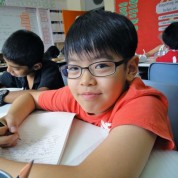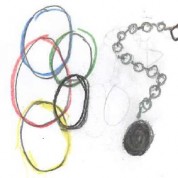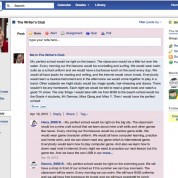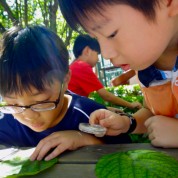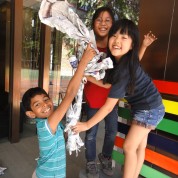Strategies make all the difference.
The word of the week in Grade 4 is strategy. We have learned that applying the right strategies makes all the difference to our learning. This week, each person chose 2 learning stations: one represented an area of strength and one was an area of weakness. We pre-tested ourselves, then applied some learning strategies, then tested ourselves again. For example, at the logical station, people made lists, drew pictures and found patterns to solve hard Maths problems. At the musical station, people clapped rhythms, sang melodies and wrote the letters above the notes. At the visual-spatial station, people used basic shapes, shadows and hatching to improve their drawings. Here’s someone at the musical intelligence. Look at that concentration! Here’s someone at the bodily-kinesthetic station. Their strategies were watching the ball, keeping the bounces low and only moving their wrists. We’ve had great fun this week but Ms O’Dwyer designed the tasks. Next week, we are in charge of our own potential! We are making action plans and taking charge of our own strengths and weaknesses. Stay tuned! Which strategies worked well at each station? Which strategies didn’t work? Did you use more than one intelligence at each station? Tell us about this....
Read MoreDoodling Designers
Yesterday we strengthened our visual spatial intelligence. We asked our art teacher, Miss Davies, to help us understand how visual intelligence is useful in the world. She told us about people who are architects, graphic designers, advertisers, fashion designers and typographers. Inspired by the designers at Google, we decided to re-design our own names. We aimed to use line, colour, theme and shadow to create eye-catching images and fill a space. Here are some examples: Can you recognise our names? Which is your favorite? What can you learn about a person just by looking at their design? Miss Davies is now helping us strengthen our visual-spatial intelligence even further. In Art lessons, we are becoming real typographers and designing a whole alphabet of letters. Stay tuned to see our display...
Read MoreOur teacher is still learning
Our teacher, Ms O’Dwyer, has a lot to learn about technology. She is still trying to understand how digital tools help us become better learners. Here’s some research she did recently about Edmodo. (This is boring for kids – but might be interesting for parents or other teachers)....
Read MoreUnder the Magnifying Glass
Today we strengthened our naturalist intelligence. We went hunting! We took clipboards and magnifying glasses into the playground to find living things we don’t normally notice. We focused on scientific observation and recording skills. We looked closely at features, sketched details and added informative labels. Some people became fixed on a particular insect or leaf. They spent all their time sketching and marvelling at one object. Other people took many samples of insects and plants. When we returned to class, we wrote detailed descriptions and reflected on our most interesting discoveries. Then we discussed natural intelligence in greater depth. Did you know it was the last intelligence to be added to Howard Gardner’s theory? We began to think about the value of naturalist intelligence in the world today. Keep your thinking hats on. Why is naturalist intelligence important in the world? What other intelligences could be used to make an impact on the natural...
Read MoreThe Teamwork Challenge
Today we strengthened our interpersonal intelligence, by working in teams. We brainstormed ways to make a team successful. We thought about skills such as communicating, accepting others’ ideas and resolving conflicts. Then each team was given a 20-minute challenge: to build the tallest tower possible, using only newspaper and tape. We had a few successes, a few disasters and lots of fun! Here’s one of our efforts. Little did we know, Ms O’Dwyer was recording our conversations. When we went back to class, she read back to us the things we had said. We reflected on whether each comment showed strong or weak interpersonal intelligence. Some of the best interpersonal conversations included: “How should we do this?” “What do you think of this idea?” “I understand what you’re saying.” “Can I help you by…?” “Let’s give each person a different job.” Some of the worst interpersonal conversations happened when people were rushing, panicking and yelling. We laughed and groaned when Ms O’Dwyer read these conversations back to us: “Get me the tape!” “You’re doing it wrong!” “That’s not going to work!” “You didn’t … and you didn’t…” “This is hopeless.” “HURRY UP!” We each reflected on how well our teams communicated, accepted ideas and resolved conflicts. We began to understand that working with other people can help us achieve. Now let’s do some more thinking: Which traits of the Learning Profile are linked to interpersonal intelligence? (And why?) Which PYP skills & attitudes would build interpersonal intelligence? (And why?) ...
Read More


